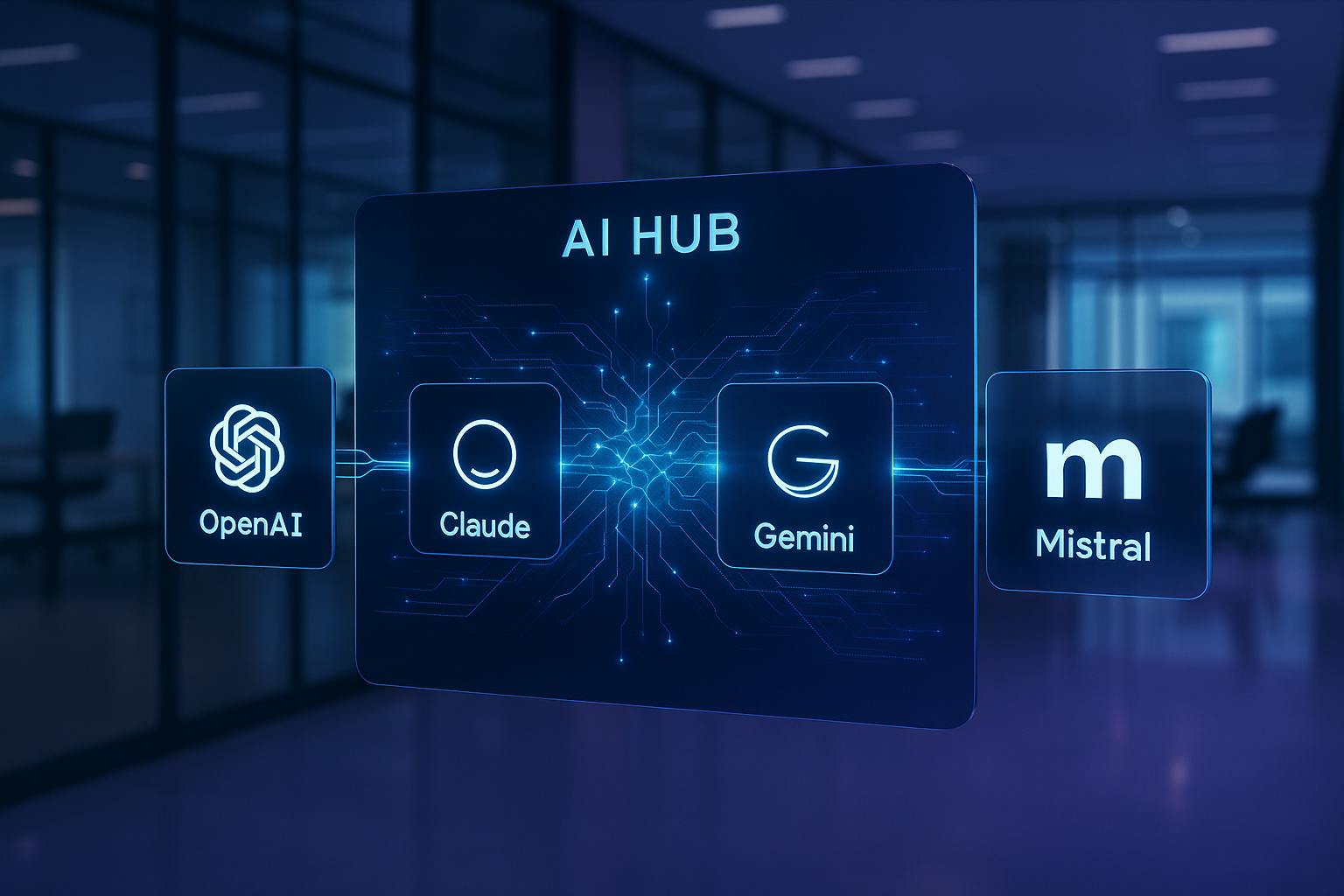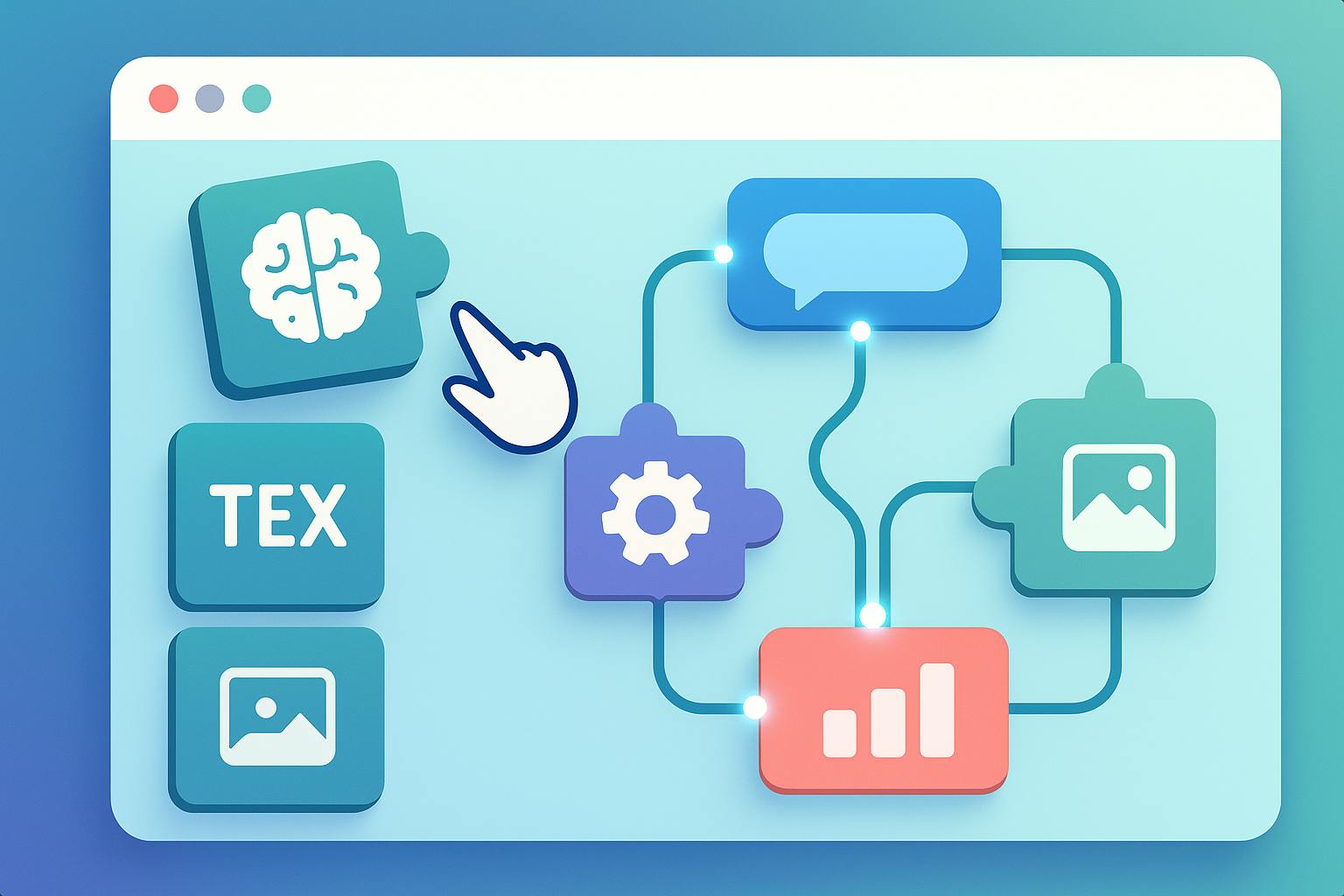Table of contents :
Enterprise AI Portal: 5 essential features to transform your business
Comprehensive guide to enterprise AI portals featuring multi-AI hub capabilities, sophisticated agent creation, no-code interfaces, intelligent automation, and secure governance for business transformation.
Artificial intelligence is no longer the exclusive domain of tech giants. Today, enterprise AI portals democratize access to the most advanced technologies, enabling any organization to harness the power of AI without massive technical investments. These centralized platforms are radically transforming how businesses approach automation, productivity, and innovation.
A modern enterprise AI portal must meet five fundamental requirements: simplified access to diverse AI models, creation of personalized intelligent agents, an intuitive interface without technical barriers, advanced automation capabilities, and secure resource governance. These features determine the difference between a simple collection of AI tools and a true digital transformation platform.
In this expert guide, we analyze the five essential features that define a best-in-class enterprise AI portal, their concrete impact on productivity, and how to choose the solution that fits your organizational challenges.
1. Multi-AI hub: centralized access to 80+ AI models
Evolution of AI aggregation
The first essential feature of a high-performing enterprise AI portal lies in its ability to centralize access to a vast range of artificial intelligence models. Gone are the days when businesses had to juggle multiple subscriptions, disparate interfaces, and complex authentication processes.
An effective multi-AI hub aggregates the market's most advanced technologies: OpenAI GPT-4o, Claude 4 Sonnet, Gemini Pro, Mistral Large, Perplexity Pro, GPT Image, Google Veo3, and dozens of other specialized models. This diversity allows teams to select the optimal tool according to their specific needs: text generation, document analysis, visual creation, programming, or advanced research.
Concrete operational advantages
The impact on productivity is immediate. Rather than wasting time navigating between different platforms, your team members access all AI capabilities from a single interface. This centralization generates productivity gains of 40 to 60% according to industry studies, primarily through reduced usage friction and workflow optimization.
Budget management is also simplified. Instead of multiple separate billings and contracts, the company benefits from a consolidated approach with clear visibility on AI resource usage by team, project, or department.
Selection criteria for a multi-AI hub
To evaluate the quality of a multi-AI hub, several criteria are decisive:
- Model diversity: The platform should offer at least 50+ models covering all enterprise use cases (text, image, code, audio, video).
- Technological freshness: The latest versions of flagship models should be available quickly after their official release.
- Performance and latency: Response times must remain under 3 seconds to maintain usage fluidity.
- Unified interface: The user experience should be consistent regardless of the selected model.

2. Sophisticated AI agent creation: custom-built artificial intelligence
Beyond generic chatbot limitations
The second crucial feature of a modern enterprise AI portal concerns the ability to create personalized and sophisticated AI agents. Unlike generic solutions, these agents are configured specifically to meet your organization's business needs.
A sophisticated AI agent combines several elements: personalized instructions that define its role and expertise, a knowledge base fed by your internal documents, specialized skills that extend its capabilities, and a personality adapted to your company culture.
Architecture and advanced personalization
The most effective enterprise AI agents rely on a modular architecture enabling extensive customization. Each agent can be configured with:
- Sophisticated system prompts that precisely define its domain of expertise, communication style, and operational limits.
- A proprietary knowledge base fed by your internal documents, procedures, product databases, and specialized content. This contextual knowledge allows the agent to provide accurate and up-to-date responses about your business specifics.
- Extended skills that connect the agent to your existing tools: CRM, ERP, databases, external APIs, document management systems.
- A selectable AI model according to task complexity: fast models for simple interactions, advanced models for complex analyses.
Use cases
Sophisticated AI agents concretely transform enterprise operations:
- Customer support agent: Handles 80% of first-level requests, accesses product knowledge bases, intelligently escalates to human teams.
- Financial analysis agent: Analyzes financial reports, generates executive summaries, identifies trends and anomalies.
- Intelligent HR agent: Answers questions about internal policies, assists in the recruitment process, helps with administrative management.
- Creative marketing agent: Generates content adapted to your tone of voice, optimizes campaigns according to your guidelines, analyzes performance.
3. No-code interface: AI accessible without technical barriers
Democratizing artificial intelligence
The third essential feature of an effective enterprise AI portal lies in its no-code approach. This philosophy ensures that artificial intelligence remains accessible to all team members, regardless of their technical skills.
A successful no-code interface is characterized by its ease of use, visual approach, and intuitive logic. Users create, configure, and deploy complex AI solutions without writing a single line of code, thanks to drag-and-drop interfaces, guided configuration assistants, and ready-to-use templates.
Components of an optimal no-code interface
- Visual agent builder: Graphical interface allowing configuration of agent parameters, instructions, personality, and skills through simple selection and module configuration.
- Intuitive knowledge manager: Document upload and organization via drag-and-drop, automatic indexing, and data source configuration without technical manipulation.
- Industry template library: Pre-configured agents for the most common use cases (customer support, document analysis, sales assistant, etc.) customizable in just a few clicks.
- Plug-and-play skills system: Catalog of ready-to-integrate capabilities (API connections, data export, web search, etc.) activatable without development.
Impact on organizational adoption
The no-code approach transforms AI adoption in enterprises. Studies show that organizations using no-code platforms achieve an adoption rate of 85% versus 25% for traditional technical solutions.
This democratization allows business teams to become autonomous in creating their AI solutions, reducing dependence on IT teams and significantly accelerating the time-to-value of artificial intelligence projects.
Organizational benefits include: 70% reduction in deployment timelines, 60% decrease in development costs, and 80% increase in user satisfaction.

4. Intelligent automation: optimizing business processes
Beyond simple task scheduling
The fourth fundamental feature of an enterprise AI portal concerns its intelligent automation capabilities. Unlike traditional automation tools, AI automation adapts to contexts, makes intelligent decisions, and evolves according to usage patterns.
Intelligent automation combines recurring task scheduling, contextual data analysis, autonomous decision-making, and continuous learning. This approach enables automation of complex processes that previously required systematic human intervention.
AI automation architecture
- Intelligent triggers: Automation triggers according to multiple criteria (temporal, event-based, conditional) and adapts to business context.
- Adaptive workflows: Automated processes evolve according to results obtained, continuously optimizing their effectiveness.
- Ecosystem integration: Native connection with your existing tools (CRM, ERP, messaging, databases) for end-to-end automation.
- Monitoring and optimization: Real-time performance tracking, bottleneck identification, and automatic improvement suggestions.
Concrete use cases
- Marketing automation: Automatic generation of personalized content according to customer segments, real-time campaign optimization, intelligent lead scoring.
- Automated HR processes: Candidate pre-qualification, evaluation report generation, automated training and certification tracking.
- Intelligent document management: Automatic classification of incoming documents, data extraction and structuring, knowledge base updates.
- Proactive customer support: Automatic detection of recurring issues, generation of personalized responses, intelligent escalation according to complexity.
Measuring automation ROI
Intelligent automation generates significant measurable gains:
- Repetitive task reduction: 60-80% of administrative tasks automated
- Quality improvement: 40% reduction in human errors
- Process acceleration: 50-70% time savings on critical workflows
- Resource optimization: Refocusing teams on high-value-added tasks
5. Governance and secure sharing: mastering AI usage
Security and control: enterprise AI fundamentals
The fifth essential feature of a professional enterprise AI portal concerns governance and secure resource sharing. This critical dimension determines the organization's ability to deploy AI at scale while maintaining control, security, and regulatory compliance.
Effective AI governance revolves around granular access management, cost and resource control, usage traceability, and compliance with security standards. These elements guarantee controlled and secure deployment of artificial intelligence in the professional environment.
Access and permission management
- Granular role system: Attribution of specific permissions according to responsibilities (administrator, advanced user, standard user) with precise control of accessible features.
- Workspace management: Team organization in dedicated workspaces with selective sharing of agents, knowledge, and resources according to projects and departments.
- AI model control: Access limitation to certain models according to user profiles, ensuring appropriate and controlled use of the most advanced technologies.
- Complete audit trail: Exhaustive traceability of user actions, interaction history, and usage monitoring for compliance and optimization.
Intelligent credit sharing
Resource management constitutes a major challenge in enterprise AI deployment. An intelligent credit sharing system enables:
- Fair distribution: AI resource allocation according to departmental needs, project priorities, and allocated budgets.
- Real-time monitoring: Consumption tracking by user, team, and project with automatic alerts in case of overrun.
- Cost optimization: Usage pattern analysis to identify possible optimizations and avoid resource waste.
- Internal billing: Transparent AI cost distribution according to actual usage by each department or project.
Security and compliance
- End-to-end encryption: Protection of sensitive data during exchanges with AI models, guaranteeing confidentiality of business-critical information.

- Secure hosting: Infrastructure respecting enterprise security standards (ISO 27001, SOC 2) with European hosting options for GDPR compliance.
- Data control: Guarantee of non-use of customer data for model training, with possibility of complete history deletion.
- Regulatory compliance: Respect for sector regulations (GDPR, HIPAA, etc.) with documentation and processes adapted to compliance requirements.
Choosing the right enterprise AI portal: selection criteria
Technical and functional evaluation
Choosing an enterprise AI portal requires rigorous evaluation according to several critical dimensions:
- Technology coverage: Verify the diversity and quality of proposed AI models, their update frequency, and their relative performance.
- Integration ease: Evaluate connection capabilities with your existing ecosystem (APIs, native connectors, supported data formats).
- Scalability: Ensure the solution can support your growth in terms of users, data volume, and use case complexity.
- Support and training: Consider the quality of proposed support (documentation, training, technical support, user community).
Strategic considerations
- Product vision: Favor solutions supported by a clear roadmap and sustained R&D investments to guarantee technological evolution.
- Partner ecosystem: Verify the existence of a partner and integrator ecosystem to facilitate deployment and maintenance.
- Customer references: Analyze use cases similar to your context and feedback from comparable organizations.
- Economic model: Evaluate cost transparency and predictability, as well as alignment with your budget constraints.
Enterprise AI within reach
Enterprise AI portals fundamentally transform the organizational approach to artificial intelligence. By centralizing access to dozens of advanced models, simplifying the creation of sophisticated agents, democratizing usage through no-code interfaces, automating business processes, and guaranteeing secure governance, these platforms truly democratize enterprise AI.
The challenge is no longer whether your organization will adopt artificial intelligence, but how it will do so effectively. Companies that equip themselves today with a high-performing AI portal gain a decisive competitive advantage, optimizing their productivity, accelerating their innovation, and preparing their digital transformation.
Choosing the right platform determines the success of your AI strategy. Prioritize solutions that combine technological excellence, ease of use, and rigorous governance to maximize your return on investment and guarantee successful deployment of artificial intelligence in your organization.
author
OSNI

Published
October 15, 2025